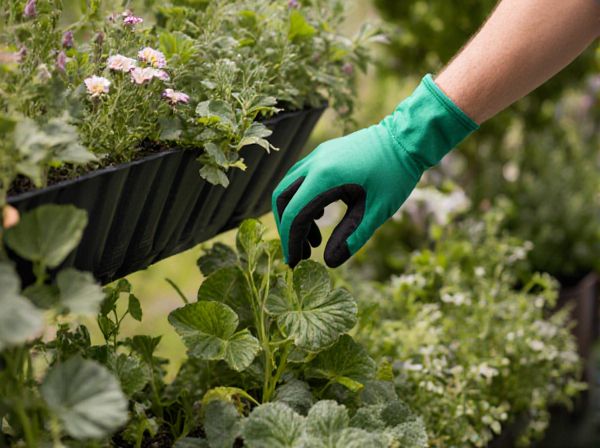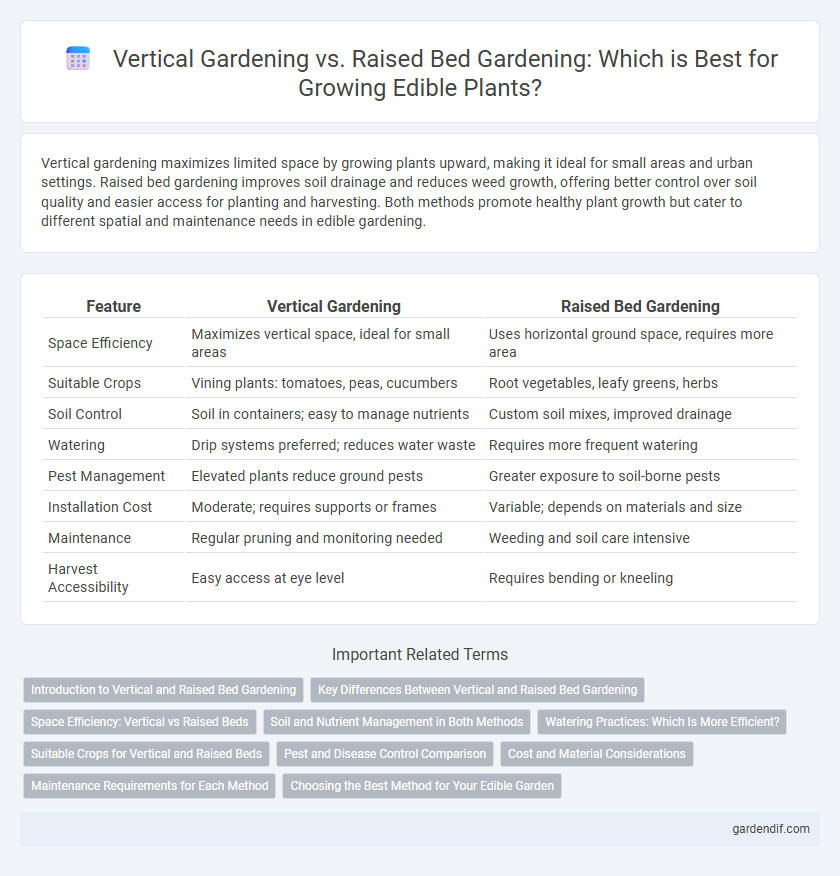
Vertical gardening vs Raised bed gardening Illustration
Vertical gardening maximizes limited space by growing plants upward, making it ideal for small areas and urban settings. Raised bed gardening improves soil drainage and reduces weed growth, offering better control over soil quality and easier access for planting and harvesting. Both methods promote healthy plant growth but cater to different spatial and maintenance needs in edible gardening.
Table of Comparison
| Feature | Vertical Gardening | Raised Bed Gardening |
|---|---|---|
| Space Efficiency | Maximizes vertical space, ideal for small areas | Uses horizontal ground space, requires more area |
| Suitable Crops | Vining plants: tomatoes, peas, cucumbers | Root vegetables, leafy greens, herbs |
| Soil Control | Soil in containers; easy to manage nutrients | Custom soil mixes, improved drainage |
| Watering | Drip systems preferred; reduces water waste | Requires more frequent watering |
| Pest Management | Elevated plants reduce ground pests | Greater exposure to soil-borne pests |
| Installation Cost | Moderate; requires supports or frames | Variable; depends on materials and size |
| Maintenance | Regular pruning and monitoring needed | Weeding and soil care intensive |
| Harvest Accessibility | Easy access at eye level | Requires bending or kneeling |
Introduction to Vertical and Raised Bed Gardening
Vertical gardening maximizes space by growing plants upward using structures like trellises, cages, or walls, ideal for small gardens and urban settings. Raised bed gardening involves cultivating soil in elevated containers or frames, enhancing drainage, soil quality, and accessibility for a variety of vegetables and herbs. Both methods optimize plant growth and yield, but vertical gardening is space-efficient while raised beds improve soil management.
Key Differences Between Vertical and Raised Bed Gardening
Vertical gardening maximizes space by growing plants upward on structures such as trellises or walls, ideal for small areas and vining crops like beans and cucumbers. Raised bed gardening involves planting in elevated soil beds, offering improved drainage, soil control, and easier access for root vegetables and leafy greens. Key differences include spatial efficiency, plant support methods, and suitability for various plant types, with vertical gardening emphasizing height and raised beds focusing on soil depth and quality.
Space Efficiency: Vertical vs Raised Beds
Vertical gardening maximizes limited space by utilizing vertical surfaces, allowing for higher plant density and efficient use of height, ideal for small urban areas. Raised bed gardening optimizes ground-level soil quality and offers easier control over soil conditions but requires more horizontal space. While raised beds provide better accessibility and root depth, vertical gardens significantly enhance space efficiency through upward growth.
Soil and Nutrient Management in Both Methods
Vertical gardening maximizes soil efficiency using minimal space by employing nutrient-rich growing mediums, often requiring frequent monitoring and supplementation of fertilizers to maintain plant health. Raised bed gardening offers enhanced soil control, allowing for customized nutrient management and improved drainage, which supports robust root development and higher yields. Both methods demand careful attention to soil composition and nutrient levels to optimize plant growth and productivity.
Watering Practices: Which Is More Efficient?
Vertical gardening uses less water due to improved air circulation and faster soil drying, reducing overwatering risk compared to raised bed gardening. Raised beds retain moisture longer because of their soil volume and structure, often requiring less frequent watering but potentially leading to water runoff. Efficient watering in vertical gardens can be achieved with drip irrigation systems, optimizing water use by targeting plant roots directly.
Suitable Crops for Vertical and Raised Beds
Vertical gardening is ideal for climbing crops such as beans, peas, cucumbers, and tomatoes, which benefit from vertical space and support structures. Raised bed gardening suits root vegetables like carrots, beets, and radishes, as well as leafy greens including lettuce, spinach, and kale, due to its loose soil conditions and better drainage. Both methods optimize growth environments, but crop selection depends on the plant's growth habit and root development needs.
Pest and Disease Control Comparison
Vertical gardening limits soil contact, reducing the risk of soil-borne pests and diseases, while improved air circulation helps prevent fungal infections. Raised bed gardening offers better drainage and soil control, which minimizes root rot and attracts beneficial insects that naturally reduce pest populations. Both methods provide targeted environments that enhance pest and disease management, but vertical gardening excels in space efficiency and disease prevention through elevation.
Cost and Material Considerations
Vertical gardening requires less soil and space, often utilizing lightweight, inexpensive materials like plastic or metal frames, making it cost-effective for small areas. Raised bed gardening involves more substantial investment in soil, wood, or composite materials, leading to higher upfront costs but improved soil control and durability. Selecting materials for either method depends on budget constraints, available space, and long-term gardening goals.
Maintenance Requirements for Each Method
Vertical gardening demands regular pruning and training to support plant growth and maximize space efficiency, often requiring more frequent monitoring for pests and irrigation adjustments. Raised bed gardening typically involves less intensive upkeep, focusing on soil conditioning, weeding, and occasional reinforcement of bed structures to maintain plant health and soil quality. Both methods benefit from consistent watering schedules and nutrient management, but vertical setups generally require higher day-to-day maintenance to sustain optimal plant development.
Choosing the Best Method for Your Edible Garden
Vertical gardening maximizes space by growing crops like tomatoes, cucumbers, and beans upward on trellises or towers, ideal for small patios or urban settings. Raised bed gardening offers improved soil control, better drainage, and easier access for root vegetables, leafy greens, and herbs, making it suitable for larger garden plots with varied crop needs. Selecting the best method depends on available space, crop types, and maintenance preferences, ensuring optimal yield and plant health for your edible garden.
Vertical gardening vs Raised bed gardening Infographic

 gardendif.com
gardendif.com